Related Research Articles

Bordeaux is a city on the river Garonne in the Gironde department, southwestern France. A port city, it is the capital of the Nouvelle-Aquitaine region, as well as the prefecture of the Gironde department. Its inhabitants are called "Bordelais" (masculine) or "Bordelaises" (feminine). The term "Bordelais" may also refer to the city and its surrounding region.

White wine is a wine that is fermented without skin contact. The colour can be straw-yellow, yellow-green, or yellow-gold. It is produced by the alcoholic fermentation of the non-coloured pulp of grapes, which may have a skin of any colour. White wine has existed for at least 4,000 years.

Bordeaux wine is produced in the Bordeaux region of southwest France, around the city of Bordeaux, on the Garonne River. To the north of the city, the Dordogne River joins the Garonne forming the broad estuary called the Gironde; the Gironde department, with a total vineyard area of 110,800 hectares, is the largest wine-growing area in France.

Libourne is a commune in the Gironde department in Nouvelle-Aquitaine in southwestern France. It is a sub-prefecture of the department.
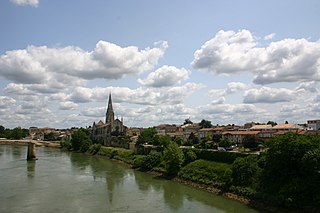
Langon is a commune in the Gironde department in Nouvelle-Aquitaine in southwestern France. Langon serves as the seat of its district, canton and subprefecture. Its inhabitants are called Langonnais and Langonnaise.
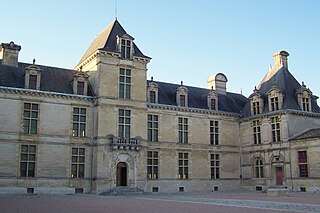
Cadillac-sur-Garonne is a commune in the Gironde department in Nouvelle-Aquitaine in southwestern France.

California wine has a long and continuing history, and in the late twentieth century became recognized as producing some of the world's finest wine. While wine is made in all fifty U.S. states, up to 90% of American wine is produced in the state. California would be the fourth largest producer of wine in the world if it were an independent nation.
Gros Verdot is a red French wine grape variety that was a historically important grape in the Gironde wine region of Bordeaux but plantings of the variety have been banned in the region since 1946 with the grape no longer being a permitted variety in any AOC Bordeaux wines.
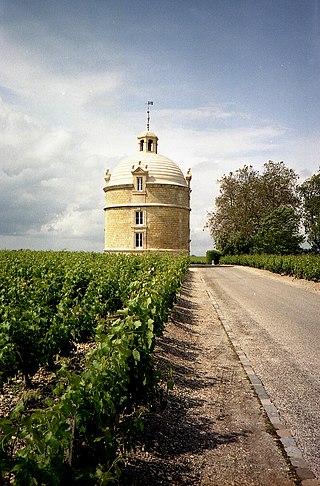
Bordeaux wine spans almost 2000 years to Roman times when the first vineyards were planted. In the Middle Ages, the marriage of Henry Plantagenet and Eleanor of Aquitaine opened the Bordeaux region to the English market and eventually to the world's stage. The Gironde estuary and its tributaries, the Garonne and the Dordogne rivers play a pivotal role in the history and success of this region.

The Great French Wine Blight was a severe blight of the mid-19th century that destroyed many of the vineyards in France and laid waste to the wine industry. It was caused by an aphid that originated in North America and was carried across the Atlantic in the late 1850s. The actual genus of the aphid is still debated, although it is largely considered to have been a species of Daktulosphaira vitifoliae, commonly known as grape phylloxera. While France is considered to have been worst affected, the blight also did a great deal of damage to vineyards in other European countries.

Béguey is a commune on the right bank of the Garonne river in the Gironde department in southwestern France.

Cubzac-les-Ponts, also referred to as Cubzac, is a commune of the Gironde department in Nouvelle-Aquitaine, a region in southwestern France. Located 20 km northeast of Bordeaux, it is a crossing point of the river Dordogne. Cubzac has three bridges, one designed by Gustave Eiffel.
Château La Fleur-Pétrus is a Bordeaux wine from the appellation Pomerol. The winery is located on the Right Bank of the Bordeaux wine region, in the commune of Pomerol in the department Gironde. As all wine produced in this appellation, La Fleur-Pétrus is unclassified but the estate is estimated among the great growths of the region.

Don Pedro Sainsevain was a French-born Californian vintner, ranchero, and a signer of the Californian Constitution in 1849. He is best known for his role in Californian winemaking, as one of the first producers of sparkling wine in California. He also was an early participant in the California Gold Rush.
Rancho Cañada del Rincon en el Rio San Lorenzo was a 5,827-acre (23.58 km2) Mexican land grant in present-day Santa Cruz County, California given in 1843 by Governor Manuel Micheltorena, and confirmed in 1846 by Governor Pío Pico, to Pedro Sainsevain. The name means "valley on a corner on the San Lorenzo River". The grant was north of present-day Santa Cruz on the San Lorenzo River.

Denis Dubourdieu was a French winemaker and professor of oenology at the University of Bordeaux. He managed or co-managed several properties in Bordeaux, including Château Reynon, Château Doisy Daëne, Château Cantegril, Château Haura, and Clos Floridène. He also consulted at Château Cheval Blanc and 4G Wines.

Solomon Lazard, also known as S. Lazard, (1827–1916) was an entrepreneur in 19th century Los Angeles, California, a member of the city council there in 1854, and founder of S. Lazard & Co.
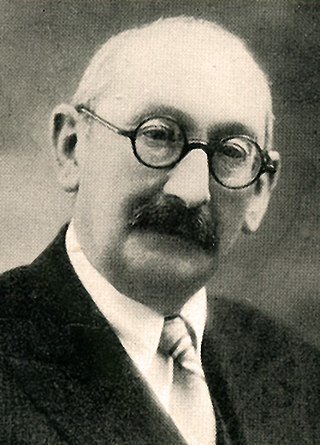
Joseph Marie Capus was a French agriculturalist and expert on grape vines. He became a deputy in the French national parliament, and was Minister of Agriculture for a few months in 1924. He was active in legislation related to agriculture and was the driving force behind introduction of the Appellation d'origine contrôlée for French wines.
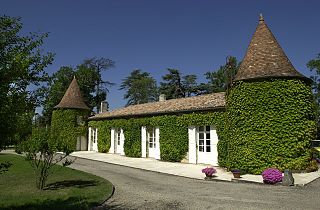
Château Suau is a French vineyard located south of the village of Capian in the Bordeaux area. It sits at the highest point of the Cadillac-côtes-de-Bordeaux appellation. Château Suau produces organic wines.
Jean-Didier Vincent is a French neurobiologist and neuropsychiatrist. He was Professor of Physiology at the Faculty of Medicine of the University of Bordeaux II and then at the University of Paris-Sud. From 1991 to 2004 Vincent was Director of the Alfred-Fessard Institute of Neurobiology at the CNRS. He has been a member of both the French Academy of Sciences and the French Academy of Medicine since 18 November 2003.
References
- ↑ R. Irvine & W. Clore The Wine Project pg 41 Sketch Publications 1997 ISBN 0-9650834-9-7
- ↑ Jore, Léonce. Le Bordelais Jean-Louis Vignes, Pionnier de la Viticulture en Californie. Revue historique de Bordeaux et du departement de la Gironde. Bordeaux Avril-Juin 1959. Page 136
- ↑ Contract signed on December 30, 1816 in the offices of Maître Desarnault, notary in Cadillac. Archives Départementales de la Gironde, Bordeaux, France
- ↑ Journal du Palais présentant la jurisprudence de la cour de cassation et des courts d'appel de Paris et des autres départements. Tome II. Paris 1830. Page 116
- ↑ Jore, Léonce. op.cit. Page 136
- ↑ Mouly, R.P. SS.CC. De la Guillotine aux Iles du Pacifique. Le Père Marie-Joseph Coudrin Fondateur de la Congrégation des Sacrés-Coeurs 1768-1837. Tolra, Editeur. Paris 1939. Page 156
- ↑ Mouly, R.P. SS.CC. Des Français en Amérique Espagnole (1827-1957). Lectures Missionaires. Paris 1957. Pages 12-18
- ↑ De Morineau, Philippe. Précis Historique de l’Expédition des Iles Sandwich et des Causes de sa Mauvaise Réussite. Nouvelles Annales des Voyages et des Sciences Géographiques. Tome 61. Paris, Janvier, Février, Mars 1834. Page 316
- ↑ Davis, William Heath. Op.cit. Page 1
- ↑ Foucrier, Annick. Le rêve californien. Migrants français sur la côte Pacifique. Éditions Belin. Paris 1999. Page 52
- ↑ Carosso, Vincent P. Op.cit. Page 172
- ↑ Gaughan, Tim (June 19, 2009). "Where the valley met the vine: The Mexican period". Napa Valley Register . Napa, CA: Lee Enterprises, Inc. Retrieved September 30, 2011.
- ↑ Idwall, Jones. Vines in the Sun: A Journey Through the California Vineyards. William Morrow and Co. New York, 1949. Page 212
- ↑ Newmark, Harris, Sixty Years in Southern California 1853-1913. Fourth Edition. Dawson's Book Shop, Los Angeles 1984. Page 200
- ↑ Foucrier, Annick. Op. Cit. Page 62
- ↑ Foucrier, Annick. Op. Cit. Page 53
- ↑ McGroarty, John Steven. History of Los Angeles County. The American Historical Society. Chicago and New York 1923. Page 31
- ↑ Davis, William Heath. Seventy Five Years in California. John Howell. San Francisco. 1929. Page 120
- ↑ History of the French community in Los Angeles Consulate General of France in Los Angeles Archived August 11, 2006, at the Wayback Machine
- ↑ McGroarty, John Steven. Los Angeles, From the Mountains to the Sea. The American Historical Society. Chicago and New York. 1921. Page 189
- ↑ Carosso, Vincent P. The California Wine Industry 1830-1895. University of California Press. Berkeley and Los Angeles, 1951. Page 10
- ↑ Foucrier, Annick. Op. Cit. Page 39
- ↑ Newmark, Harris (1916). Sixty years in Southern California, 1853-1913, containing the reminiscences of Harris Newmark. New York: The Knickerbocker Press. p. 198.
Further reading
- Macconnell, Scott (2011-02-01). "Jean-Louis Vignes: California's Forgotten Winemaker". Gastronomica: The Journal of Critical Food Studies. 11 (1): 89–92. doi:10.1525/gfc.2011.11.1.89. ISSN 1533-8622. PMID 21591314 . Retrieved 2018-09-16.